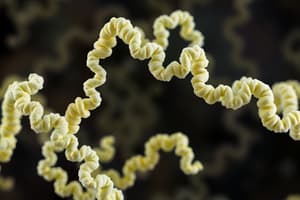Podcast
Questions and Answers
Which suffix is commonly used to identify enzymes?
Which suffix is commonly used to identify enzymes?
- -ose
- -ine
- -ene
- -ase (correct)
What is the function of Amylase?
What is the function of Amylase?
Helps digest starch
What does the primary structure of a protein refer to?
What does the primary structure of a protein refer to?
Specific sequence of amino acids
What is the role of the catalytic site in an enzyme?
What is the role of the catalytic site in an enzyme?
Each enzyme is specific to a substrate.
Each enzyme is specific to a substrate.
What is the function of enzymes like trypsin?
What is the function of enzymes like trypsin?
Which enzyme is involved in unwinding DNA during replication?
Which enzyme is involved in unwinding DNA during replication?
The _____ is the area that recognizes the substrate molecule in an enzyme.
The _____ is the area that recognizes the substrate molecule in an enzyme.
What are the two models of enzyme-substrate interaction?
What are the two models of enzyme-substrate interaction?
What is the function of Acetylcholinesterase?
What is the function of Acetylcholinesterase?
The _____ states that enzymes lower the activation energy required for a chemical reaction.
The _____ states that enzymes lower the activation energy required for a chemical reaction.
Flashcards are hidden until you start studying
Study Notes
Enzyme Structure and Function
- Enzymes are vital to the body's normal functions.
- Many enzymes end with the suffix "-ase."
- Amylase in saliva helps digest starch.
- Trypsin in the small intestine aids in protein breakdown.
- Helicase unwinds DNA during replication and also breaks down lactose.
Protein Structure
- Primary structure: The specific sequence of amino acids in a polypeptide chain.
- Secondary structure: The protein's folding pattern (e.g., alpha helix, beta sheet).
- Tertiary structure: How polypeptides form the shape of the molecule.
- Quaternary structure: The subunits of the protein.
Enzyme Structure
- Binding site: Amino acid residues that bind or accommodate the substrate molecule.
- Catalytic site: Amino acid residues in the active site that catalyze reactions after binding occurs.
Enzyme-Substrate Complexes
- Substrates: Molecules whose reactions are catalyzed by enzymes.
- Products: Formed after the enzyme and substrate bind and the reaction occurs.
- Each enzyme is specific to a particular substrate.
Enzyme-Substrate Models
- Lock-and-Key Model: The specific shape between the active site and substrate allows only specific binding.
- Induced Fit Model: Initial interaction is weak, but the bond strengthens as the active site modifies.
Remember
- A good indicator of an enzyme is the presence of the "-ase" suffix.
- However, not all enzymes end with "-ase."
- Notable examples include the digestive enzymes pepsin, pepsinogen, trypsin, and rennin.
Functions of Enzymes
- Catalysis: Speeds up chemical reactions specific to the substrate and enzyme.
- Diverse Roles in the Body: Enzymes participate in numerous bodily functions.
- Cellular Processes: Enzymes are pivotal in various cellular processes.
Enzymes as Catalysts
- Catalysis: Increases reaction rates.
- Enzymes lower activation energy, which is the energy needed for a chemical reaction to begin.
- Enzymes modify reactants into a transition state, which allows for faster catalysis.
Enzymes' Roles in the Body
- Digestion: Enzymes like amylase, trypsin, pepsin, lactase, and others aid in breaking down molecules for digestion.
- Cell division: Enzymes like cyclin-dependent kinases (Cdks) modify proteins for cell division.
- Nervous function: Acetylcholinesterase breaks down acetylcholine, essential for nerve function.
- DNA replication: Enzymes such as helicase and DNA polymerase assist in DNA replication.
Summary
- Enzymes are biomolecules that accelerate chemical reactions within cells.
- Cells need a vast amount of energy for chemical reactions, so enzymes are crucial.
- Each enzyme has an active site that recognizes and binds to a specific substrate molecule.
- Enzymes are essential for many cellular processes and bodily functions.
Studying That Suits You
Use AI to generate personalized quizzes and flashcards to suit your learning preferences.



